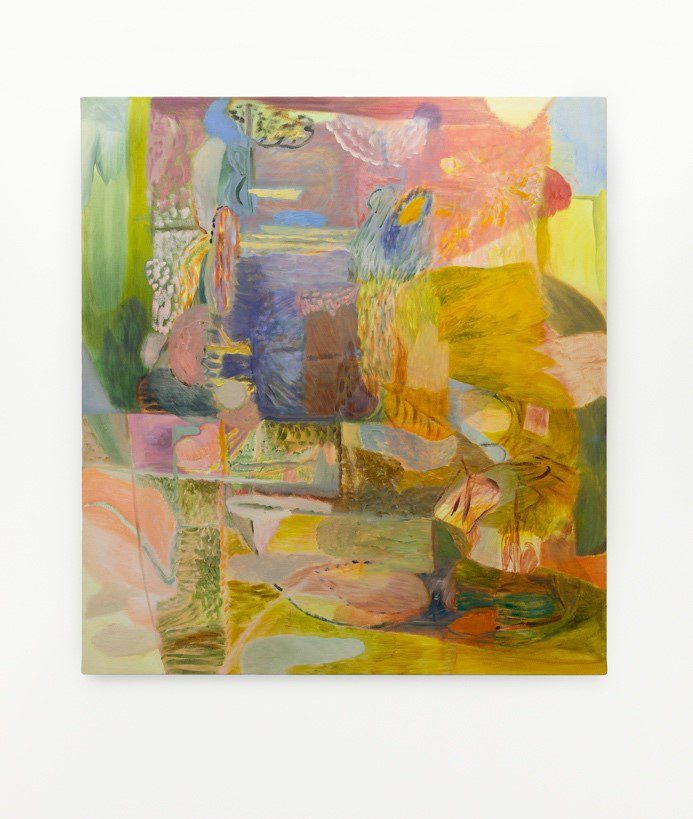The exhibition’s title, Slim glimpses, derives from what Amy has referred to as ‘small moments’ that break through and briefly interrupt our everyday activities:
‘There is a birch tree outside our flat, and I make a point of touching it and looking up. And for one moment, for one glimpse, I am thinking of the tree as a different sort of being and how different that is from me as a person, as a human…Then I go on to do my normal daily things.’ Whilst developing this exhibition, Amy has drawn on the work of writers Donna Haraway, Karen Barad, Matthew Hall and Robin Wall Kimmerer. She has said: ‘I was thinking of this research in tandem with my own experience of being in the world. There are glimpses of hope in the reframing of who we are and how we live to include all those we are entangled with, human and nonhuman, in order to cultivate a better way to live with the world.’
In her short essay, Caitlin Merritt King suggests: ‘Painting, for Amy, is a way of putting down roots.’ The body of work included in Slim glimpses is rich in allusions to foliage, trees, clouds, fields, sunny orbs, hills and water discernible across the canvases. Amy grew up in Dalry in rural Dumfries and Galloway, and she spent her childhood immersed in the countryside. This has clearly profoundly influenced her sense of connectedness to the natural world, which, in turn, suffuses her work. More domestic references can be picked out too – hints of a bright window or perhaps the edge of a building are perceptible in paintings such as Name Us to Love Us or Always Already Becoming, along with elements of her home life: ‘When I was doing this body of work, I was thinking a lot about a houseplant in our bedroom called a fishbone cactus…and what it’s doing with the sorts of spaces in between and the shadows.’
Amy describes her process in the studio as open and quite fluid, typically constellating around a number of simultaneous activities. When painting she moves between making conscious marks based on memory and using her intuition based on mood, feeling and thoughts: ‘I might make a mark that I am remembering, but also a mixture of intuitive mark-making along with all these thoughts that are going around in my head about the title…they all merge slowly together.’ She might listen to a podcast, she may switch to painting in her sketchbooks and painting on the canvases, or she might read a book or look up an artist’s monograph as gradually things start to emerge and the work evolves.
Amy works on many canvases at the same time, sometimes moving them around the studio, on the wall, on the floor, or sometimes just at her desk, almost not looking at what she’s doing: ‘That’s what’s painting is for me, it’s like a continual movement in flux and even in the medium itself.’ This can extend across bodies of work; Amy worked on new paintings for Slim glimpses and for her exhibition Lost Hap with Margot Samel in New York at the same time: ‘There are crossovers…I find that happens anyway in the work.’ Consequently, all though they are each distinct, the individual canvases have a kind of kinship or bond: ‘I want them to do different things in themselves and be doing different things to the viewer…I try and change palettes as I am working, but because I tend to work on them all at once…the palette can then bleed in to the next.’
Amy has also developed a prodigious sketchbook practice, which she sees as integral to what she is doing. Her sketchbooks are a way for her to work on a different scale, using up paint left over on the palette, and to help her ‘remember to loosen myself up again with the actual act of painting.’ Sometimes the paintings take weeks to evolve and sometimes they come together really quickly. She has said that she likes to vary the texture and action in her paintings, using dry brush strokes that give luminosity to canvases such as Reverberative Business or New Nothing, or sections of wet on wet, as with the beautiful small work Tilt. She also acknowledges that the paint itself moves her in a certain direction: ‘Just the way that the paint forms on the canvas also makes you move it in a certain direction, or the relationship between different colours make you do a more staccato kind of brushstroke…there’s all that going on at the same time.’

